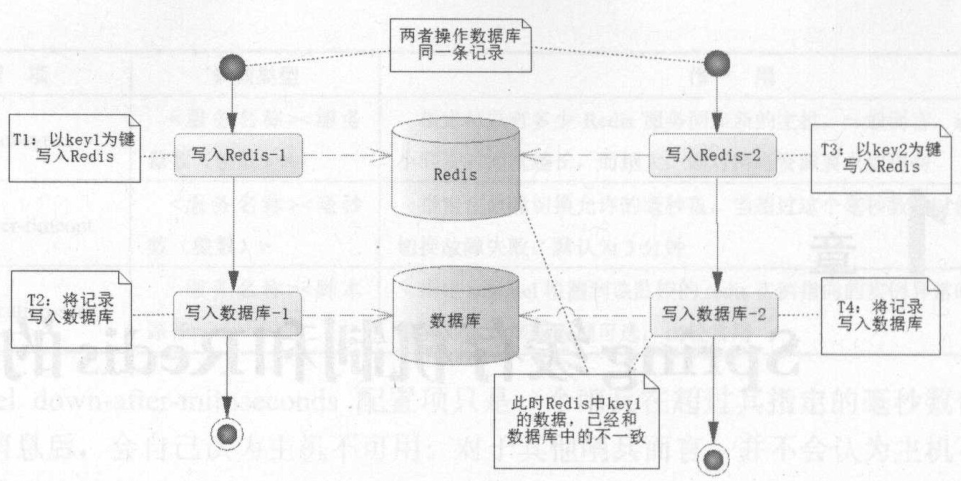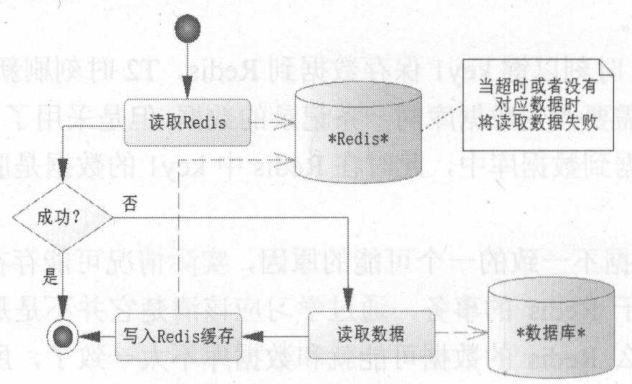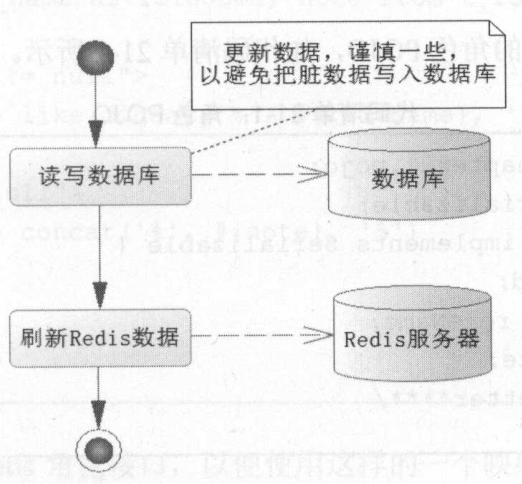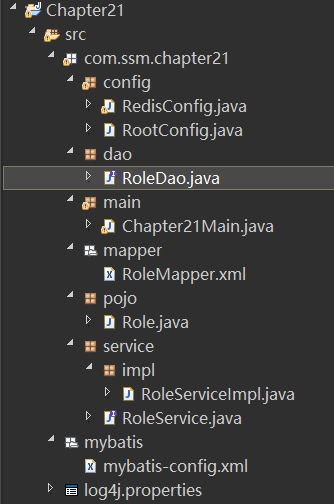一、Redis和数据库的结合
使用Redis可以优化性能,但是存在Redis的数据和数据库同步的问题。
例如,T1时刻以将 key1 保存数据到 Redis,T2时刻刷新进入数据库,但是T3时刻发生了其他业务需要改变数据库同一条记录的数据,但是采用了 key2 保存到Redis中,然后又写入了更新数据到数据库中,这就导致 Redis 中key1 的数据是脏数据,和数据库中的数据不一致。

1.Redis和数据库读操作
数据缓存往往会在 Redis 上设置超时时间,当设置 Redis 的数据超时后,Redis 就没法读出数据了,这个时候就会触发程序读取数据库,然后将读取数据库数据写入 Redis,并给数据重设超时时间,这样程序在读取的过程中就能按一定的时间间隔刷新数据了。

public DataObject readMethod(args) { DataObject data = getRedis(key); if(data != null){ data = getFromDataBase(); writeRedis(key, data); setRedisExpire(key, 5); } return data; }
2. Redis 和数据库写操作
写操作要考虑数据一致的问题,尤其是那些重要的业务数据,所以首先应该考虑从数据库中读取最新的数据,然后对数据进行操作,最后把数据写入 Redis 缓存中。

写入业务数据时,应该先从数据库中读取最新数据,然后进行业务操作,更新业务数据到数据库后,再将数据刷新到 Redis 缓存中,这样就能避免将脏数据写入数据库中。
public DataObject writeMethod(args) { DataObject data = getFromDataBase(args); ExecLogic(data); updateDataBase(data); updateRedisData(data); }
二、使用Spring缓存机制整合Redis

1.定义一个POJO类和Mybatis

package com.ssm.chapter21.pojo; import java.io.Serializable; public class Role implements Serializable { private static final long serialVersionUID = -1194462093889377366L; private Long id; private String roleName; private String note; /**** setter and getter ****/ }

<?xml version="1.0" encoding="UTF-8" ?> <!DOCTYPE configuration PUBLIC "-//mybatis.org//DTD Config 3.0//EN" "http://mybatis.org/dtd/mybatis-3-config.dtd"> <configuration> <mappers> <mapper resource="com/ssm/chapter21/mapper/RoleMapper.xml"/> </mappers> </configuration>

<?xml version="1.0" encoding="UTF-8" ?> <!DOCTYPE mapper PUBLIC "-//mybatis.org//DTD Mapper 3.0//EN" "http://mybatis.org/dtd/mybatis-3-mapper.dtd"> <mapper namespace="com.ssm.chapter21.dao.RoleDao"> <select id="getRole" resultType="com.ssm.chapter21.pojo.Role"> select id, role_name as roleName, note from t_role where id = #{id} </select> <delete id="deleteRole"> delete from t_role where id=#{id} </delete> <insert id="insertRole" parameterType="com.ssm.chapter21.pojo.Role" useGeneratedKeys="true" keyProperty="id"> insert into t_role (role_name, note) values(#{roleName}, #{note}) </insert> <update id="updateRole" parameterType="com.ssm.chapter21.pojo.Role"> update t_role set role_name = #{roleName}, note = #{note} where id = #{id} </update> <select id="findRoles" resultType="com.ssm.chapter21.pojo.Role"> select id, role_name as roleName, note from t_role <where> <if test="roleName != null"> role_name like concat('%', #{roleName}, '%') </if> <if test="note != null"> note like concat('%', #{note}, '%') </if> </where> </select> </mapper>

package com.ssm.chapter21.dao; import java.util.List; import org.apache.ibatis.annotations.Param; import org.springframework.stereotype.Repository; import com.ssm.chapter21.pojo.Role; /**** imports ****/ @Repository public interface RoleDao { public Role getRole(Long id); public int deleteRole(Long id); public int insertRole(Role role); public int updateRole(Role role); public List<Role> findRoles(@Param("roleName") String roleName, @Param("note") String note); }

package com.ssm.chapter21.service; import java.util.List; import com.ssm.chapter21.pojo.Role; public interface RoleService { public Role getRole(Long id); public int deleteRole(Long id); public Role insertRole(Role role); public int updateRole(Role role); public List<Role> findRoles(String roleName, String note); public int insertRoles(List<Role> roleList); }
2.通过Java配置Spring
RootConfig.java的定义,其中包含了4个部分
package com.ssm.chapter21.config;/**** imports ****/ @Configuration // 定义Spring扫描的包 @ComponentScan("com.*") // 使用事务驱动管理器 @EnableTransactionManagement // 实现接口TransactionManagementConfigurer,这样可以配置注解驱动事务 public class RootConfig implements TransactionManagementConfigurer {
private DataSource dataSource = null;
...
}
(1)配置数据库
/** * 配置数据库 * * @return 数据连接池 */ @Bean(name = "dataSource") public DataSource initDataSource() { if (dataSource != null) { return dataSource; } Properties props = new Properties(); props.setProperty("driverClassName", "com.mysql.jdbc.Driver"); props.setProperty("url", "jdbc:mysql://localhost:3306/chapter6?useSSL=false"); props.setProperty("username", "root"); props.setProperty("password", "bjtungirc"); try { dataSource = BasicDataSourceFactory.createDataSource(props); } catch (Exception e) { e.printStackTrace(); } return dataSource; }
(2)配置SqlSessionFactoryBean
/** * * 配置SqlSessionFactoryBean * * @return SqlSessionFactoryBean */ @Bean(name = "sqlSessionFactory") public SqlSessionFactoryBean initSqlSessionFactory() { SqlSessionFactoryBean sqlSessionFactory = new SqlSessionFactoryBean(); sqlSessionFactory.setDataSource(initDataSource()); // 加载Mybatis配置文件 Resource resource = new ClassPathResource("mybatis/mybatis-config.xml"); sqlSessionFactory.setConfigLocation(resource); return sqlSessionFactory; }
(3)配置Mybatis Mapper
/** * * 通过自动扫描,发现Mybatis Mapper映射器 * * @return Mapper映射器 */ @Bean public MapperScannerConfigurer initMapperScannerConfigurer() { MapperScannerConfigurer msc = new MapperScannerConfigurer(); // 定义扫描包 msc.setBasePackage("com.*"); msc.setSqlSessionFactoryBeanName("sqlSessionFactory"); // 区分注解扫描 msc.setAnnotationClass(Repository.class); return msc; }
(4)配置注解驱动,使得@Transactional可以触发事务
/** * 实现接口方法,注册注解事务,当@Transactional使用的时候产生数据库事务 */ @Override @Bean(name = "annotationDrivenTransactionManager") public PlatformTransactionManager annotationDrivenTransactionManager() { DataSourceTransactionManager transactionManager = new DataSourceTransactionManager(); transactionManager.setDataSource(initDataSource()); return transactionManager; }
3.通过Java配置RedisTemplate和Redis缓存管理器
RedisConfig.java,其中包含两个部分,RedisTemplate和Redis缓存管理器
其中@EnableCaching 表示Spring IoC 容器启动了缓存机制。
package com.ssm.chapter21.config;/**** imports ****/ @Configuration @EnableCaching public class RedisConfig {...}
(1)RedisTemplate配置
@Bean(name = "redisTemplate") public RedisTemplate initRedisTemplate() { JedisPoolConfig poolConfig = new JedisPoolConfig(); // 最大空闲数 poolConfig.setMaxIdle(50); // 最大连接数 poolConfig.setMaxTotal(100); // 最大等待毫秒数 poolConfig.setMaxWaitMillis(20000); // 创建 Jedis 连接工厂 JedisConnectionFactory connectionFactory = new JedisConnectionFactory(poolConfig); connectionFactory.setHostName("localhost"); connectionFactory.setPort(6379); // 调用后初始化方法,没有它将抛出异常 connectionFactory.afterPropertiesSet(); // 自定义两个Redis序列化器 RedisSerializer jdkSerializationRedisSerializer = new JdkSerializationRedisSerializer(); RedisSerializer stringRedisSerializer = new StringRedisSerializer(); // 定义RedisTemplate对象,并设置连接工程 RedisTemplate redisTemplate = new RedisTemplate(); redisTemplate.setConnectionFactory(connectionFactory); // 设置序列化器 redisTemplate.setDefaultSerializer(stringRedisSerializer); redisTemplate.setKeySerializer(stringRedisSerializer); redisTemplate.setValueSerializer(jdkSerializationRedisSerializer); redisTemplate.setHashKeySerializer(stringRedisSerializer); redisTemplate.setHashValueSerializer(jdkSerializationRedisSerializer); return redisTemplate; }
(2)配置Redis缓存管理器
定义默认超时时间为10分钟,这样就可以在一定的时间间隔后重新从数据库中读取数据了。另外redisCacheManager名称在之后的业务方法中也会用到。
@Bean(name = "redisCacheManager") public CacheManager initRedisCacheManager(@Autowired RedisTemplate redisTempate) { RedisCacheManager cacheManager = new RedisCacheManager(redisTempate); // 设置默认超时时间,为10分钟 cacheManager.setDefaultExpiration(600); // 设置缓存管理器名称 List<String> cacheNames = new ArrayList<String>(); cacheNames.add("redisCacheManager"); cacheManager.setCacheNames(cacheNames); return cacheManager; }
4.缓存注解说明
- @Cacheable:表明在进入方法之前,Spring会先去缓存服务器中查找对应key的缓存值,如果找打缓存值,那么Spring将不会再调用方法,而是将缓存值读出,返回给调用者;如果没有找到缓存值,那么Spring就会执行自定义的方法,将最后的结果通过key保存到缓存服务器中
- @CachaPut:Spring 会将该方法返回的值缓存到缓存服务器中,Spring不会事先去缓存服务器中查找,而是直接执行方法,然后缓存。就该方法始终会被Spring所调用
- @CacheEvict:移除缓存对应的key的值
- @Caching:分组注解,能够同时应用于其他缓存的注解
上面的注解都能标注到类或者方法上,如果放到类上,则对所有的方法都有效;如果放在方法上,则只是对方法有效。在大部分情况下,会放置到方法上。
一般而言,对于查询,可以使用@Cacheable;对于插入和修改,可以使用@CachePut;对于删除操作,可以使用@CacheEvict
@Cacheable和@CachaPut的配置属性为:
- value(String[]):使用缓存管理器的名称
- condition(String):Spring表达式,如果返回值为false,则不会将缓存应用到方法上
- key(String):Spring表达式,通过它来计算对应缓存的key
- unless(String):Spring表达式,如果表达式的返回值为true,则不会将方法的结果放到缓存上
RoleService接口的实现类中的方法的定义为:
package com.ssm.chapter21.service.impl;/**** imports ****/ @Service public class RoleServiceImpl implements RoleService { // 角色DAO,方便执行SQL @Autowired private RoleDao roleDao = null;
...
}
(1)使用@Cacheable注解的getRole方法
在Spring的调用中,会先查询Redis中看是否存在key为redis_role_id的键值对,如果有,就返回结果。如果没有,就访问getRole方法,从数据库中查询到数据,返回给调用者,然后将键值对redis_role_id---roleDao.getRole(id)保存到Redis中。
/** * 使用@Cacheable定义缓存策略 当缓存中有值,则返回缓存数据,否则访问方法得到数据 通过value引用缓存管理器,通过key定义键 * @param id 角色编号 * @return 角色对象 */ @Override @Transactional(isolation = Isolation.READ_COMMITTED, propagation = Propagation.REQUIRED) @Cacheable(value = "redisCacheManager", key = "'redis_role_'+#id") public Role getRole(Long id) { return roleDao.getRole(id); }
(2)使用@CachePut注解的insertRole方法和updateRole方法
由于需要先执行insertRole把对应的信息更新到数据库,然后才能刷新Redis。因此,Spring会先执行roleDao.insertRole(role);,然后根据return得到的role,将redis_role_role.id---role保存到Redis中。而updateRole方法也是同理,先执行updateRole方法更新对象,然后将redis_role_role.id---role保存到Redis中。保存到Redis中的过程都遵循redisCacheManager缓存管理器定义的过程。
/** * 使用@CachePut则表示无论如何都会执行方法,最后将方法的返回值再保存到缓存中 * 使用在插入数据的地方,则表示保存到数据库后,会同期插入到Redis缓存中 * * @param role 角色对象 * @return 角色对象(会回填主键) */ @Override @Transactional(isolation = Isolation.READ_COMMITTED, propagation = Propagation.REQUIRED) @CachePut(value = "redisCacheManager", key = "'redis_role_'+#result.id") public Role insertRole(Role role) { roleDao.insertRole(role); return role; } /** * 使用@CachePut,表示更新数据库数据的同时,也会同步更新缓存 * * @param role 角色对象 * @return 影响条数 */ @Override @Transactional(isolation = Isolation.READ_COMMITTED, propagation = Propagation.REQUIRED) @CachePut(value = "redisCacheManager", key = "'redis_role_'+#role.id") public int updateRole(Role role) { return roleDao.updateRole(role); }
(3)使用@CacheEvict注解的deleteRole方法在方法,可以执行完成后会移除对应的缓存,
/** * 使用@CacheEvict删除缓存对应的key * * @param id 角色编号 * @return 返回删除记录数 */ @Override @Transactional(isolation = Isolation.READ_COMMITTED, propagation = Propagation.REQUIRED) @CacheEvict(value = "redisCacheManager", key = "'redis_role_'+#id") public int deleteRole(Long id) { return roleDao.deleteRole(id); }
(4)测试@CachePut注解、@Cacheable和@CacheEvict注解:
package com.ssm.chapter21.main; public class Chapter21Main { public static void main(String[] args) { //使用注解Spring IoC容器 ApplicationContext ctx = new AnnotationConfigApplicationContext(RootConfig.class, RedisConfig.class); //获取角色服务类 RoleService roleService = ctx.getBean(RoleService.class); Role role = new Role(); role.setRoleName("role_name_1"); role.setNote("role_note_1"); //插入角色 roleService.insertRole(role); //获取角色 Role getRole = roleService.getRole(role.getId()); getRole.setNote("role_note_1_update"); //更新角色 roleService.updateRole(getRole); //删除角色 roleService.deleteRole(getRole.getId()); } }
输出日志:
在第二部分getRole部分可以看到,只出现了两次Opening RedisConnection和Closing Redis Connection而没有出现任何SQL执行,因为在Redis中已经先查找到了对应的数据。
Creating new transaction with name [com.ssm.chapter21.service.impl.RoleServiceImpl.insertRole]: PROPAGATION_REQUIRED,ISOLATION_READ_COMMITTED; ''
Acquired Connection [jdbc:mysql://localhost:3306/chapter6?useSSL=false, UserName=root@, MySQL-AB JDBC Driver] for JDBC transaction
Changing isolation level of JDBC Connection [jdbc:mysql://localhost:3306/chapter6?useSSL=false, UserName=root@, MySQL-AB JDBC Driver] to 2
Switching JDBC Connection [jdbc:mysql://localhost:3306/chapter6?useSSL=false, UserName=root@, MySQL-AB JDBC Driver] to manual commitCreating a new SqlSession Registering transaction synchronization for SqlSession [org.apache.ibatis.session.defaults.DefaultSqlSession@71e2843b] JDBC Connection [jdbc:mysql://localhost:3306/chapter6?useSSL=false, UserName=root@, MySQL-AB JDBC Driver] will be managed by Spring ==> Preparing: insert into t_role (role_name, note) values(?, ?) ==> Parameters: role_name_1(String), role_note_1(String) <== Updates: 1Releasing transactional SqlSession [org.apache.ibatis.session.defaults.DefaultSqlSession@71e2843b] Opening RedisConnection Closing Redis Connection Transaction synchronization committing SqlSession [org.apache.ibatis.session.defaults.DefaultSqlSession@71e2843b] Transaction synchronization deregistering SqlSession [org.apache.ibatis.session.defaults.DefaultSqlSession@71e2843b] Transaction synchronization closing SqlSession [org.apache.ibatis.session.defaults.DefaultSqlSession@71e2843b] Initiating transaction commit Committing JDBC transaction on Connection [jdbc:mysql://localhost:3306/chapter6?useSSL=false, UserName=root@, MySQL-AB JDBC Driver] Resetting isolation level of JDBC Connection [jdbc:mysql://localhost:3306/chapter6?useSSL=false, UserName=root@, MySQL-AB JDBC Driver] to 4 Releasing JDBC Connection [jdbc:mysql://localhost:3306/chapter6?useSSL=false, UserName=root@, MySQL-AB JDBC Driver] after transaction Returning JDBC Connection to DataSource
Adding transactional method 'RoleServiceImpl.getRole' with attribute: PROPAGATION_REQUIRED,ISOLATION_READ_COMMITTED; ''Adding cacheable method 'getRole' with attribute: [Builder[public com.ssm.chapter21.pojo.Role com.ssm.chapter21.service.impl.RoleServiceImpl.getRole(java.lang.Long)] caches=[redisCacheManager] | key=''redis_role_'+#id' | keyGenerator='' | cacheManager='' | cacheResolver='' | condition='' | unless='' | sync='false'] Creating new transaction with name [com.ssm.chapter21.service.impl.RoleServiceImpl.getRole]: PROPAGATION_REQUIRED,ISOLATION_READ_COMMITTED; ''Acquired Connection [jdbc:mysql://localhost:3306/chapter6?useSSL=false, UserName=root@, MySQL-AB JDBC Driver] for JDBC transaction Changing isolation level of JDBC Connection [jdbc:mysql://localhost:3306/chapter6?useSSL=false, UserName=root@, MySQL-AB JDBC Driver] to 2 Switching JDBC Connection [jdbc:mysql://localhost:3306/chapter6?useSSL=false, UserName=root@, MySQL-AB JDBC Driver] to manual commit Opening RedisConnection Closing Redis Connection Opening RedisConnection Closing Redis Connection Initiating transaction commit Committing JDBC transaction on Connection [jdbc:mysql://localhost:3306/chapter6?useSSL=false, UserName=root@, MySQL-AB JDBC Driver] Resetting isolation level of JDBC Connection [jdbc:mysql://localhost:3306/chapter6?useSSL=false, UserName=root@, MySQL-AB JDBC Driver] to 4 Releasing JDBC Connection [jdbc:mysql://localhost:3306/chapter6?useSSL=false, UserName=root@, MySQL-AB JDBC Driver] after transaction Returning JDBC Connection to DataSource
Adding transactional method 'RoleServiceImpl.updateRole' with attribute: PROPAGATION_REQUIRED,ISOLATION_READ_COMMITTED; ''Adding cacheable method 'updateRole' with attribute: [Builder[public int com.ssm.chapter21.service.impl.RoleServiceImpl.updateRole(com.ssm.chapter21.pojo.Role)] caches=[redisCacheManager] | key=''redis_role_'+#role.id' | keyGenerator='' | cacheManager='' | cacheResolver='' | condition='' | unless=''] Creating new transaction with name [com.ssm.chapter21.service.impl.RoleServiceImpl.updateRole]: PROPAGATION_REQUIRED,ISOLATION_READ_COMMITTED; ''Acquired Connection [jdbc:mysql://localhost:3306/chapter6?useSSL=false, UserName=root@, MySQL-AB JDBC Driver] for JDBC transaction DChanging isolation level of JDBC Connection [jdbc:mysql://localhost:3306/chapter6?useSSL=false, UserName=root@, MySQL-AB JDBC Driver] to 2 Switching JDBC Connection [jdbc:mysql://localhost:3306/chapter6?useSSL=false, UserName=root@, MySQL-AB JDBC Driver] to manual commitCreating a new SqlSession Registering transaction synchronization for SqlSession [org.apache.ibatis.session.defaults.DefaultSqlSession@6636448b] JDBC Connection [jdbc:mysql://localhost:3306/chapter6?useSSL=false, UserName=root@, MySQL-AB JDBC Driver] will be managed by Spring ==> Preparing: update t_role set role_name = ?, note = ? where id = ? ==> Parameters: role_name_1(String), role_note_1_update(String), 7(Long) <== Updates: 1Releasing transactional SqlSession [org.apache.ibatis.session.defaults.DefaultSqlSession@6636448b] Opening RedisConnection Closing Redis Connection Transaction synchronization committing SqlSession [org.apache.ibatis.session.defaults.DefaultSqlSession@6636448b] Transaction synchronization deregistering SqlSession [org.apache.ibatis.session.defaults.DefaultSqlSession@6636448b] Transaction synchronization closing SqlSession [org.apache.ibatis.session.defaults.DefaultSqlSession@6636448b] Initiating transaction commit Committing JDBC transaction on Connection [jdbc:mysql://localhost:3306/chapter6?useSSL=false, UserName=root@, MySQL-AB JDBC Driver] Resetting isolation level of JDBC Connection [jdbc:mysql://localhost:3306/chapter6?useSSL=false, UserName=root@, MySQL-AB JDBC Driver] to 4 Releasing JDBC Connection [jdbc:mysql://localhost:3306/chapter6?useSSL=false, UserName=root@, MySQL-AB JDBC Driver] after transaction Returning JDBC Connection to DataSource
Adding transactional method 'RoleServiceImpl.deleteRole' with attribute: PROPAGATION_REQUIRED,ISOLATION_READ_COMMITTED; ''Adding cacheable method 'deleteRole' with attribute: [Builder[public int com.ssm.chapter21.service.impl.RoleServiceImpl.deleteRole(java.lang.Long)] caches=[redisCacheManager] | key=''redis_role_'+#id' | keyGenerator='' | cacheManager='' | cacheResolver='' | condition='',false,false] Creating new transaction with name [com.ssm.chapter21.service.impl.RoleServiceImpl.deleteRole]: PROPAGATION_REQUIRED,ISOLATION_READ_COMMITTED; ''Acquired Connection [jdbc:mysql://localhost:3306/chapter6?useSSL=false, UserName=root@, MySQL-AB JDBC Driver] for JDBC transaction Changing isolation level of JDBC Connection [jdbc:mysql://localhost:3306/chapter6?useSSL=false, UserName=root@, MySQL-AB JDBC Driver] to 2 Switching JDBC Connection [jdbc:mysql://localhost:3306/chapter6?useSSL=false, UserName=root@, MySQL-AB JDBC Driver] to manual commitCreating a new SqlSession Registering transaction synchronization for SqlSession [org.apache.ibatis.session.defaults.DefaultSqlSession@1c681761] JDBC Connection [jdbc:mysql://localhost:3306/chapter6?useSSL=false, UserName=root@, MySQL-AB JDBC Driver] will be managed by Spring ==> Preparing: delete from t_role where id=?==> Parameters: 7(Long) <== Updates: 1Releasing transactional SqlSession [org.apache.ibatis.session.defaults.DefaultSqlSession@1c681761] Opening RedisConnection Closing Redis Connection Transaction synchronization committing SqlSession [org.apache.ibatis.session.defaults.DefaultSqlSession@1c681761] Transaction synchronization deregistering SqlSession [org.apache.ibatis.session.defaults.DefaultSqlSession@1c681761] Transaction synchronization closing SqlSession [org.apache.ibatis.session.defaults.DefaultSqlSession@1c681761] Initiating transaction commit Committing JDBC transaction on Connection [jdbc:mysql://localhost:3306/chapter6?useSSL=false, UserName=root@, MySQL-AB JDBC Driver] Resetting isolation level of JDBC Connection [jdbc:mysql://localhost:3306/chapter6?useSSL=false, UserName=root@, MySQL-AB JDBC Driver] to 4 Releasing JDBC Connection [jdbc:mysql://localhost:3306/chapter6?useSSL=false, UserName=root@, MySQL-AB JDBC Driver] after transaction Returning JDBC Connection to DataSource
(4)findRoles方法
使用缓存的前提是----高命中率。由于这里根据角色名称和备注查找角色信息,该方法的返回值会根据查询条件而多样化,导致其不确定和命中率低下,这种情况下使用缓存并不能有效提高性能,所以findRoles方法就不必使用缓存注解来进行标注了。
@Override @Transactional(isolation = Isolation.READ_COMMITTED, propagation = Propagation.REQUIRED) public List<Role> findRoles(String roleName, String note) { return roleDao.findRoles(roleName, note); }
(5)insertRoles方法
insertRoles方法中调用了insertRole方法,而insertRole方法本身带有注解@CachePut,这时如果要执行insertRoles方法,会发现缓存失效了。
这里失效的原因是和之前讨论过的数据库事务失效的情况一样,由于缓存注解也是使用了Spring AOP 来实现,而Spring AOP使用了动态代理,即只有代理对象的相互调用,AOP才具有拦截功能。而这里的自调用是没有代理对象存在的,因此注解功能失效。
@Override @Transactional(isolation = Isolation.READ_COMMITTED, propagation = Propagation.REQUIRED) public int insertRoles(List<Role> roleList) { for (Role role : roleList) { //同一类的方法调用自己方法,产生自调用[插入:失效]问题 this.insertRole(role); } return roleList.size(); }
